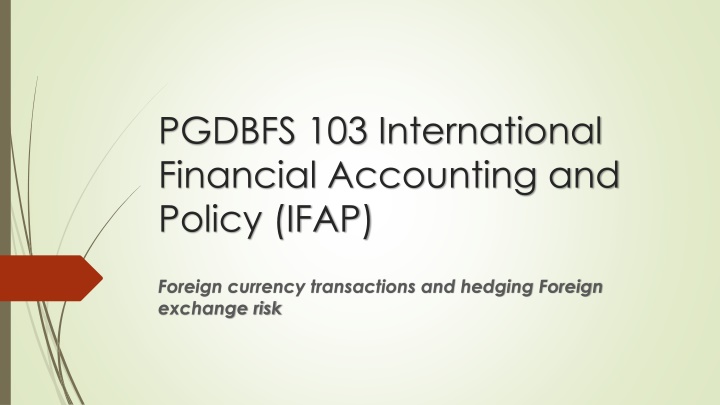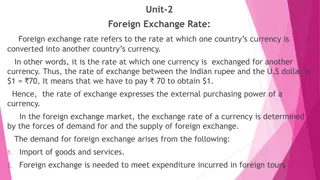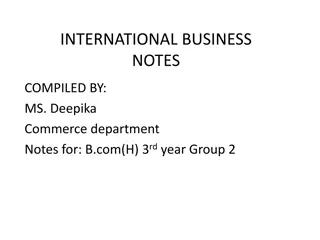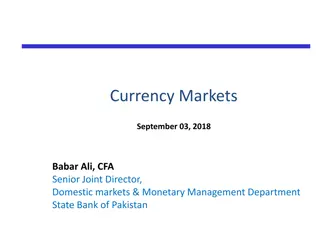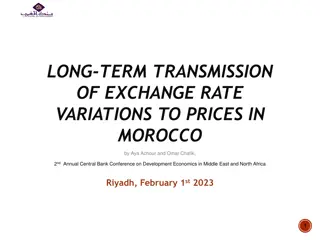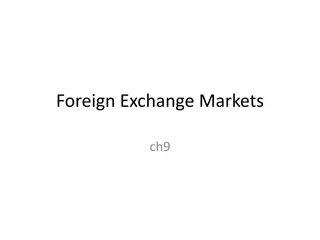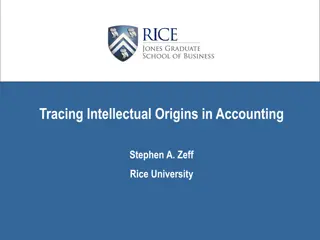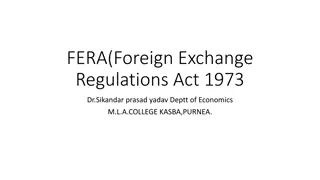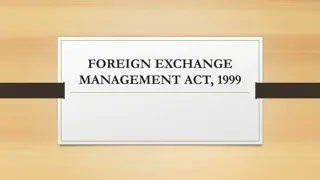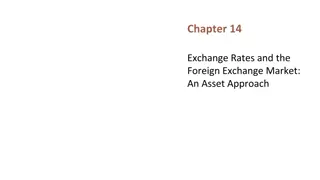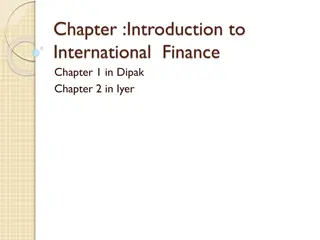International Financial Accounting and Policy: Foreign Exchange Rate Mechanisms
Foreign exchange rates play a crucial role in global economies, impacting trade balances, capital flows, and inflation rates. Understanding exchange rate mechanisms such as independent float and pegged currencies is essential for managing foreign currency transactions and hedging risks.
Download Presentation

Please find below an Image/Link to download the presentation.
The content on the website is provided AS IS for your information and personal use only. It may not be sold, licensed, or shared on other websites without obtaining consent from the author.If you encounter any issues during the download, it is possible that the publisher has removed the file from their server.
You are allowed to download the files provided on this website for personal or commercial use, subject to the condition that they are used lawfully. All files are the property of their respective owners.
The content on the website is provided AS IS for your information and personal use only. It may not be sold, licensed, or shared on other websites without obtaining consent from the author.
E N D
Presentation Transcript
PGDBFS 103 International Financial Accounting and Policy (IFAP) Foreign currency transactions and hedging Foreign exchange risk
Foreign exchange markets The price at which a foreign currency could be bought or sold is called as the foreign exchange rate (forex rate). Impact the forex rate would have on a country s economy Merchandise trade A weaker currency will stimulate exports and make imports more expensive, thereby decreasing a nation s trade deficit (or increasing surplus) over time. Conversely, a significantly stronger currency can reduce export competitiveness and make imports cheaper, which can cause the trade deficit to widen further. Capital flows Foreign capital will tend to flow into countries that have strong governments, dynamic economies and stable currencies. A nation needs to have a relatively stable currency to attract investment capital from foreign investors. Inflation A devalued currency can result in imported inflation for countries that are substantial net importers.
Exchange rate mechanisms Significant fluctuations in the forex rate is detrimental to the economy of a country. Generally the central bank of a country would intervene market forces to manage the country s forex rates. There are several different currency arrangements that countries may affect: Independent float value of the currency is allowed to fluctuate freely according to market forces, with little or no intervention from the central bank. Pegged to another country the value of the currency of fixed (pegged) in terms of a particular foreign currency, and the central bank intervenes to as necessary to maintain the fixed value. e.g. Bahamas, Cayman Islands. European monetary system (euro) in 1998, the countries comprising the Eurpoean monetary system adopted a common currency called the euro, and established the European central bank.
Foreign exchange rates Foreign exchange rates are often published with both Buy and Sell rates. e.g. 1 USD = 157LKR 159LKR The difference between the buying rate and selling rate is called the Spread Spot and Forward rates Foreign currency trades can be executed on a spot or a forward basis. Spot rate the price at which the foreign currency could be purchased or sold today. Forward rate is the price offered today to buy or sell foreign currency at a future date.
Foreign currency exposures Export sales a transaction exposure exists when an exporter allows the buyer to pay in foreign currency, and also allows the payment to be made on a future date after the sale has happened. The exporter is exposed to the risk that the foreign currency might decrease in value (depreciate) between the date of sale and the date of payment. Import purchase a transaction exposure exist when the importer is required to paying foreign currency and is allowed to pay sometime after the purchase has been made. The importer is exposed to the risk that the foreign currency might increase in price (appreciate) between the transaction date and the payment date. Financing transactions Some companies may finance its capital needs through foreign currency borrowings. For example inter-company loans denominated in parent company s currency. As both interest and principal amounts need to be repaid under unknown foreign exchange rates in future dates, such financing transactions expose companies towards forex risk. Investment transactions companies that have investments denominated in foreign currency, also faces uncertainty relating to the amounts it will realize from such investments in terms of local currency, and thus is exposed to foreign exchange risk.
Accounting alternatives Conceptually there are two methods of accounting for accounting for changes in the value of foreign currency transactions. One-transaction perspective Two-transaction perspective One-transaction perspective assumes that an export sale is not completed until the foreign currency receivable has been collected and converted in to the local currency (LKR). Two transaction perspective treats the export sale transaction and the subsequent collection of cash as two separate transactions. Balance sheet date before the payment date A question arises as to what accounting should be done if a balance sheet date falls between the date of sale and the date of payment.
Hedging foreign exchange risk Companies often use foreign currency derivatives to hedge against the effect of unfavorable changes in the value of foreign currencies. A derivative is a financial instrument with a value that is reliant upon or derived from an underlying asset, group of assets or an index. The two most common derivatives used to hedge against forex risks are foreign currency forward contracts and foreign currency options. Forward contracts - Contracts whereby two parties enters into a contract over a forward rate is known as Forward contracts . In a forward contract the two parties are committed to carry out the transaction as agreed in the future date. Options contracts an option contracts gives the holder the right, but not an obligation to trade foreign currency in the future.
Accounting for derivatives IFRS 9 Financial instruments provides the following general principals with respect to accounting for derivatives. All derivatives should be recorded on the balance sheet at fair value. Hedge accounting is acceptable for those derivatives used for hedging purposes provided the hedging relationship is clearly defined, measurable and effective. Illustration On 1 December 2017 FWD Company enters into a forward contract with its Bank to buy USD100,000 in 4 months time at a rate of LKR/USD 160. Financial yearend of the company is 31 December 2017, and on that date the Bank was offering a rate of LKR/USD 162 for similar contracts that mature in 3 months time (i.e. with the same maturity date as the previous contract, 31 March 2018). Incremental borrowing rate of the company is 10%. Calculate the fair value of the derivative forward foreign exchange contract as at 31 December 2017.
